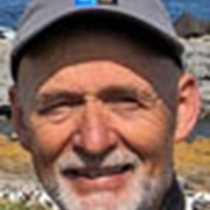Verrafjorden, Norway
At breakfast we came on deck to the sight of a fjord surrounded by conifer forest. Our captain and local pilot had somehow navigated through the eye of a needle: the mouth of Verrafjorden. This is a tiny fjord located between the island of Hitra and Trondheimfjorden. We have now left Sami culture and the huge wilderness areas of northern Norway and entered the rural, low-population landscapes of middle Norway.
As we glided towards the head of Verrafjorden, small green scraps of farmland appeared along the forested slopes. Scattered meadows indicate that these farms produce mutton, wool, milk and beef. Indeed less than 3 percent of Norway is farmland. A typical Norwegian farm consists of a few hectares of farmland plus some 50-100 hectares of productive forest. Some farmers along the coast are also still part-time fishermen. Even so, many of these farmers must get their main income from a job in a neighbouring town or village.
After breakfast our guests had a choice of kayaking, a Zodiac cruise or a walk inland to explore the coastal rainforest. One group wandered a good mile into a managed forest above the shore. Their interesting discovery of a ruined storeloft for hay, now completely reclaimed by moss and forest trees, proves that once there must have been meadows beneath what is now plantation. The other walkers pushed deeper into the forested valley beyond the plantations. We followed a standard forest road through mixed Scots pine and small spruce plantations. Once across a rocky stream, the forest opened sufficiently for wild strawberries and wild raspberries to flourish on the track sides. We did not miss the opportunity to taste these! Next we left the main track and pushed our way into a dense mass of bushes and trees. After a hard uphill climb we found ourselves at last in the core of an ancient forest. Luxuriant cushions of green moss everywhere confirmed that this was a genuine Norwegian rainforest. For the first time during this trip we were trespassers into the home of the Norwegian moose and the capercaillie, an extraordinary giant forest grouse. This was proven by a fresh moose foot-print beside the track and the discovery of a dead black grouse, probably killed by a pine marten.
After a morning full of adventure, our Assistant Expedition Leader, Lisa Trotter, gave a fascinating lecture on “Physiological adaptations to the cold.” During the recap later that afternoon, we had a chance to review all the exciting things we have seen so far. Among other themes, this included Steve MacLean’s true story of the troll with a hole in his hat. By the end of yet another day rich in experience we could easily imagine how these trolls still prowl today’s mossy wilderness in the remaining natural rainforests of coastal Norway.
At breakfast we came on deck to the sight of a fjord surrounded by conifer forest. Our captain and local pilot had somehow navigated through the eye of a needle: the mouth of Verrafjorden. This is a tiny fjord located between the island of Hitra and Trondheimfjorden. We have now left Sami culture and the huge wilderness areas of northern Norway and entered the rural, low-population landscapes of middle Norway.
As we glided towards the head of Verrafjorden, small green scraps of farmland appeared along the forested slopes. Scattered meadows indicate that these farms produce mutton, wool, milk and beef. Indeed less than 3 percent of Norway is farmland. A typical Norwegian farm consists of a few hectares of farmland plus some 50-100 hectares of productive forest. Some farmers along the coast are also still part-time fishermen. Even so, many of these farmers must get their main income from a job in a neighbouring town or village.
After breakfast our guests had a choice of kayaking, a Zodiac cruise or a walk inland to explore the coastal rainforest. One group wandered a good mile into a managed forest above the shore. Their interesting discovery of a ruined storeloft for hay, now completely reclaimed by moss and forest trees, proves that once there must have been meadows beneath what is now plantation. The other walkers pushed deeper into the forested valley beyond the plantations. We followed a standard forest road through mixed Scots pine and small spruce plantations. Once across a rocky stream, the forest opened sufficiently for wild strawberries and wild raspberries to flourish on the track sides. We did not miss the opportunity to taste these! Next we left the main track and pushed our way into a dense mass of bushes and trees. After a hard uphill climb we found ourselves at last in the core of an ancient forest. Luxuriant cushions of green moss everywhere confirmed that this was a genuine Norwegian rainforest. For the first time during this trip we were trespassers into the home of the Norwegian moose and the capercaillie, an extraordinary giant forest grouse. This was proven by a fresh moose foot-print beside the track and the discovery of a dead black grouse, probably killed by a pine marten.
After a morning full of adventure, our Assistant Expedition Leader, Lisa Trotter, gave a fascinating lecture on “Physiological adaptations to the cold.” During the recap later that afternoon, we had a chance to review all the exciting things we have seen so far. Among other themes, this included Steve MacLean’s true story of the troll with a hole in his hat. By the end of yet another day rich in experience we could easily imagine how these trolls still prowl today’s mossy wilderness in the remaining natural rainforests of coastal Norway.




